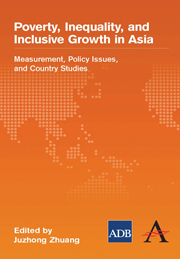Book contents
- Frontmatter
- Contents
- Foreword
- Preface and Acknowledgments
- Contributors
- Abbreviations, Acronyms, and Symbols
- Tables, Figures, and Boxes
- 1 Poverty, Inequality, and Inclusive Growth in Asia
- Part A Measuring Inequality and Poverty
- Part B Selected Policy Issues for Inclusive Growth
- Part C Country Studies
- 9 Growth, Inequality, and the Labor Market: The Philippines
- 10 Poverty and Inequality in Nepal: An Empirical Analysis
- 11 Decomposing Income Inequality: People's Republic of China, 1990–2005
- 12 Evolution of Income Mobility: People's Republic of China, 1991–2002
- 13 Occupational Segregation and Gender Discrimination in Labor Markets: Thailand and Viet Nam
- 14 Inclusiveness through Food Security: The Philippines' National Food Program
- Index
13 - Occupational Segregation and Gender Discrimination in Labor Markets: Thailand and Viet Nam
from Part C - Country Studies
Published online by Cambridge University Press: 05 March 2012
- Frontmatter
- Contents
- Foreword
- Preface and Acknowledgments
- Contributors
- Abbreviations, Acronyms, and Symbols
- Tables, Figures, and Boxes
- 1 Poverty, Inequality, and Inclusive Growth in Asia
- Part A Measuring Inequality and Poverty
- Part B Selected Policy Issues for Inclusive Growth
- Part C Country Studies
- 9 Growth, Inequality, and the Labor Market: The Philippines
- 10 Poverty and Inequality in Nepal: An Empirical Analysis
- 11 Decomposing Income Inequality: People's Republic of China, 1990–2005
- 12 Evolution of Income Mobility: People's Republic of China, 1991–2002
- 13 Occupational Segregation and Gender Discrimination in Labor Markets: Thailand and Viet Nam
- 14 Inclusiveness through Food Security: The Philippines' National Food Program
- Index
Summary
Introduction
There is a deeply unequal sharing of the burdens of life between women and men in most parts of the world. While gender inequality can take many different forms, this chapter focuses on gender inequality in earnings in the labor market–an important dimension of promoting broad-based or inclusive growth (Behrman and Zhang 1995)–in the context of Thailand and Viet Nam.
The gender pay gap is universal, but its size varies by country. This chapter analyzes the disparity in terms of three factors: individual characteristics, occupational segregation, and gender discrimination in the labor market. Of the many studies that have attempted to explain such earnings disparity, Oaxaca (1973) pioneered a decomposition methodology that explains the male-female wage gap by two components: one shows the difference due to observable male and female characteristics and the other captures the difference in the earnings' generating function, and is sometimes interpreted as a measure of discrimination. Other prominent studies on the gender differential in earnings include: Cotton (1988), which analyzed costs and benefits of discrimination; Neumark (1988), which proposed an alternative procedure from a particular Beckerian discrimination model; and Oaxaca and Ransom (1988 and 1994), which proposed a procedure to estimate the nondiscriminatory wage structure in analyzing union/non-union wage differentials.
This chapter proposes a decomposition methodology to explain the welfare disparity between male and female workers in terms of occupational segregation by gender, discrimination within occupations, and inequality in earnings.
- Type
- Chapter
- Information
- Poverty, Inequality, and Inclusive Growth in AsiaMeasurement, Policy Issues, and Country Studies, pp. 409 - 431Publisher: Anthem PressPrint publication year: 2010
- 1
- Cited by



